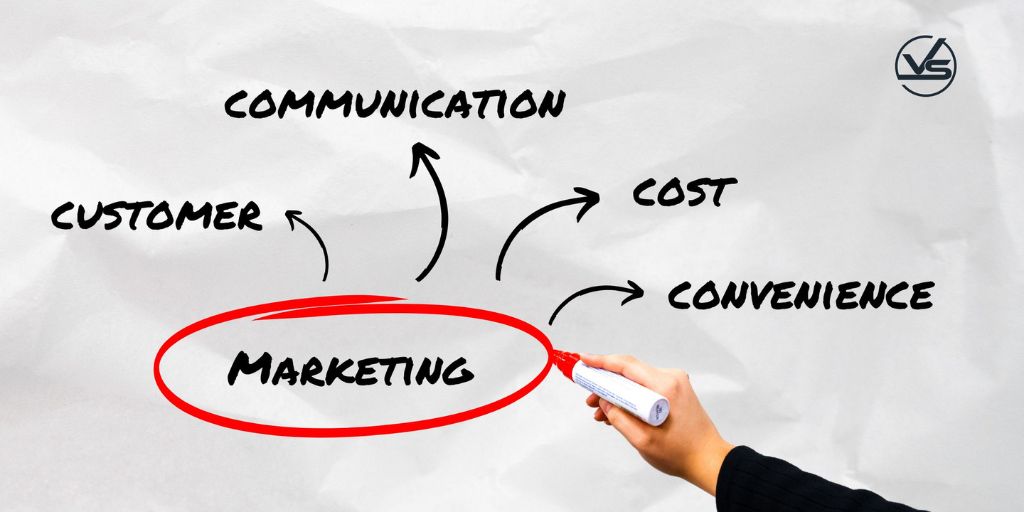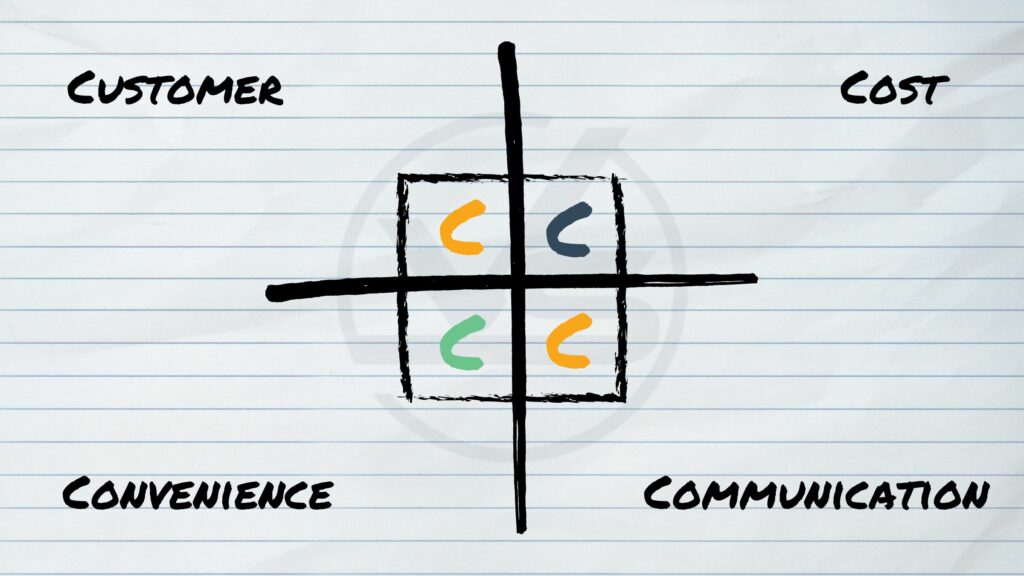
What Are the 4 Cs of Marketing?
For many years, aspiring marketers were drilled on the 4 Ps of marketing: Product, Price, Place, and Promotion. This marketing model was initially introduced in 1960 and expanded later to become the 7 Ps of the marketing mix. It was considered one of the best for assessing the competitive landscape and identifying marketing issues. However, in the past few decades, marketing gurus have replaced this old mantra with a new one, the 4 Cs of marketing:
- Customer
- Cost
- Convenience
- Communication
Nowadays, many marketers argue that these 4 Cs are much more valuable than the 4 Ps. In fact, they recommend replacing the 4 Ps with the 4 Cs. This is because the latter takes a more customer-centric approach to marketing.
You’re here because you want to learn more about the 4 Cs of marketing. More importantly, you want to determine whether you should use this model to build your marketing strategy. The good news is you’re in the right place! To help you out, we’re going to take an in-depth look at the 4 Cs and answer the question that’s probably on your mind right now: “What exactly do they mean?”
But first, a brief history lesson…
How the 4 Cs of Marketing Were Created
Although the 4 Cs of marketing have grown in popularity, many people (including a lot of marketers) don’t know where they came from. That’s why we wanted to provide some background information. Understanding why and how this model was introduced can help shed light on why it has become the preference among a lot of marketers.
So, how did the 4 Cs come to be?
It all started in 1990 when Bob Lauterborn—an advertising professor—wrote an article in Advertising Age titled “New marketing litany; Four P's passe; C-words take over.” In this article, Lauterborn stated it was time to retire McCarthy’s famous 4 Ps, as the marketing world had changed dramatically. People had become less predictable and less willing to buy whatever companies could make. And to help businesses adapt to the landscape, he suggested a new formula, Lauterborn’s 4 Cs, to serve as a replacement.
Lauterborn’s suggestions for moving away from the 4 Ps model included the following:
- Focus on consumer wants and needs vs. product.
- Consider the cost to satisfy vs. price.
- Look at convenience to buy vs. place.
- Think about communication vs. promotion.
Ultimately, Lauterborn aimed to shift from thinking about the business to thinking about the consumer. Up to that point, businesses had always taken an inside-out vs. an outside-in approach. However, Lauterborn’s model was designed to change that, as it could prove disastrous in the modern age.
“There may have been a time when you could sell anything you could make. That time is gone. Now you can only make what customers need and want. Customers don’t know what they need or want… It’s understanding people and trying to get to where it is they’re going to be 5 years from now.”
— Bob Lauterborn, “What Is the Unique Buying Proposition”
And there you have it! That’s how we got the 4 Cs of marketing.
What the 4 Cs of Marketing Represent

As mentioned previously, the 4 Cs of marketing consist of the following:
- Customer
- Cost
- Convenience
- Communication
But what exactly do they mean? Why do they matter? And how can you apply them to your own marketing efforts?
Let’s dive in…
Customer
The first “C” in the 4 Cs of marketing stands for “customer,” or, more specifically, the wants and needs of the consumer/customer. Rather than focusing on the product you are selling, this “C” reminds you to focus on solving a problem or filling a void experienced by your ideal customer. This is important, as people today aren’t looking to buy products or services. People are looking for solutions to their problems.
Businesses must understand the customers they are marketing to—it’s an essential part of developing a solid marketing strategy. The more you understand your customer, the better you will be able to make products that are useful and beneficial to them. And additionally, the better you will understand how to reach out to them in your marketing efforts.
So, take the time to create a customer avatar for each of your ideal customers. This will inform what language you use, which platforms you advertise on, what kind of content you create, and so on.
Cost
The second “C” in the 4 Cs of marketing represents “cost.” However, the cost of your product does not refer to its price. The price is only a tiny part of the overall cost that goes into buying a product—from your customers’ perspectives. You must be able to determine the overall cost of your product and deliver this information to your customers.
For example…
- How much time will it take for your customer to access your product?
- How much benefit does it actually provide?
- How much time will it take to use or set up the product?
All these things factor into your determined cost. And they should all be explained to your customers in a clear, concise, and easy-to-understand way.
Convenience

The third “C” of the 4 Cs stands for “convenience.” What this refers to specifically is convenience for your customers. How easy is it for them to get the solution you’re offering?
After you have closely studied the habits of your customers, you will know whether they prefer to shop in stores or online, as well as the extent to which they will go to purchase your product. The convenience of your product is determined in part by its overall cost. If you can make your product more cost-effective and easy enough to get without your customers having to go to great lengths to get a hold of it, then you will set yourself up for success.
Look for every opportunity to reduce friction. Consider how your customers like to buy, and be sure to provide them with their preferences. Further, outline exactly what customers need to do to make a purchase as simply as possible. Don’t confuse them or introduce 20 steps they need to take!
Communication
The fourth and final “C” of the 4 Cs of marketing covers “communication.” Communication is crucial to the success of your business marketing. You must understand how to interact with your customers. Otherwise, you’ll wind up saying the wrong thing or attempting to reach them in the wrong place—or both.
One of the best communication tools that exists for businesses today is social media. This doesn’t just mean constantly promoting your business and products on your social media networks. Instead, you should focus on developing relationships and engaging in conversations with the people who follow you. The easier it is for your customers to communicate with you, the more likely they will keep coming back.
If you’ve done your research, then you’ll know where your customers spend their time online. Make sure to prioritize the social platforms they use most frequently. And be sure to share valuable content that resonates with your ideal customer.
Where the 4 Cs Get Confusing
It’s worth noting that when the 4 Cs of marketing are mentioned, there can be some confusion. That’s because there’s more than one model. While Lauterborn introduced his formula in 1990, another team—David Jobber and John Fahy—created their own 4 Cs framework nearly 20 years later.
In the 2009 book Foundations of Marketing, Jobber and Fahy proposed the following for successful positioning:
- Clarity – Messaging must be perfectly clear.
- Consistency – The positioning statement must be consistent.
- Credibility – You must have credibility in the minds of consumers.
- Competitiveness – You must present a competitive advantage.
Although these two models are referred to in the same way, they each serve a unique purpose.
How are they different?
Lauterborn’s 4 Cs are meant to help companies build a customer-focused strategy. On a smaller scale, they can help with planning and evaluating individual campaigns. But either way, this model can guide your marketing efforts as a whole by ensuring you prioritize customer wants and needs.
Jobber and Fahy’s 4 Cs, on the other hand, are meant to be a tool for brand positioning. Their framework was created to assist with marketing communications. Adopting this framework can ensure your messaging is effective.
How to Implement the 4 Cs of Marketing
To implement the 4 Cs of marketing, you need to focus on the customer first and always. We’ve already touched on ways to do this, but you may be looking for more advice on incorporating this model into your strategy. In that case, use the tips below for guidance.
Dive into the Customer’s Wants and Needs
As a business owner, you may think you know what your customers want, but the truth is you don’t. It’s important to toss aside your own assumptions and biases, looking at what your target audience is saying, along with where they’re saying it and how they’re saying it. You must learn as much as you can about their wants and needs in relation to your offerings.
Look for Ways to Add Value
Cost will always be a consideration for customers, but there is a way to address that as a possible objection. You just need to look for ways to provide extra value to customers. This can include offering…
- Informative content to help them make the most of their purchase
- Free or discounted add-on items with their purchase
- Free delivery with purchase
- An easy checkout process that requires little time
It may even be a matter of expressing additional benefits they can look forward to after purchasing.
Simplify the Buying Experience
As mentioned above, outlining a brief, easy-to-follow plan for customers to buy your offerings is crucial. But you shouldn’t stop there. You need to make sure that every step—from discovering your offerings to completing checkout—is as simple and convenient as possible. That means you need to make sure your store/office hours are clearly posted, your customer service team is available, FAQs are addressed, your website is easy to navigate, and so forth.
Put yourself in a customer’s shoes and eliminate any barriers that may trip them up or prevent them from buying.
Prioritize Clear and Consistent Communication
When it comes to communication, there are a few factors to consider. There’s the way you communicate, the methods you use to communicate, and the frequency at which you communicate. Consistent messaging and regular interaction with your customers should be a top priority.
How do you achieve this?
- You make your messaging similar across platforms so your brand is recognizable.
- You make it easy for customers to contact you with questions or concerns.
- You address the feedback you receive from customers in a timely manner.
- You facilitate ways for customers to speak to one another (e.g., Facebook groups).
- You keep in contact with existing customers via newsletters and more.
- You conduct polls to request input from your customer base.
By creating a strong communication plan, you can make people feel listened to and valued. And that way, you can create a stronger relationship with potential and existing customers.
Takeaway
To recap, the 4 Cs of marketing (based on Bob Lauterborn’s model) refer to the following:
- Customer – The wants and needs of your ideal customer
- Cost – The overall cost of acquiring your product
- Convenience – The level of convenience for a customer to buy
- Communication – The way you interact with your customers
Lauterborn’s marketing model has become so popular because it takes the focus off the business and puts it where it belongs—the customer. So, if you’re developing a digital marketing strategy for your business, keep these 4 Cs in mind. Doing so will put you in a better position to reach, connect with, and ultimately convert your ideal customer. Do you need help building your own marketing strategy? Find out how Viral Solutions can help! Request a free consultation with us today!

